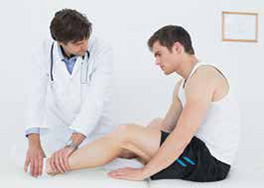
While knee and hip replacements have become more common, orthopedists are now performing an increasing number of ankle replacements as well. Total ankle arthroplasty (TAA) treats ankle arthritis that may result from the normal wear and tear of aging, or from an injury such as a dislocation or a broken ankle—arthritis that can eventually lead to loss of cartilage, pain and deformity.
If you have ankle pain that limits function and does not improve with conservative management—including anti-inflammatory medication, bracing, activity modification and physical therapy—you may be a candidate for TAA. Because it protects the surrounding joints from increased wear and thus preserves them from arthritic changes, TAA may be preferable to arthrodesis, a fusion procedure that eliminates some range of motion in the ankle and may result in progressive arthritis in the surrounding joints.
TAA is aninpatient procedure that usually requires at least one night in the hospital. Under general anesthesia or a nerve block, your ankle joint is replaced with components made of metal and high-density plastic. After the incision is closed with stitches or staples, a splint is applied, and you will wear a cast or boot to keep the implants in place while your ankle heals.
Following surgery, you will need to keep your foot elevated in order to speed healing and minimize swelling. You may be allowed to perform some gentle range-of-motion exercises; after a few weeks, you may gradually bear some weight on your ankle. But most of your walking during recovery will be done with the aid of crutches.
The total recovery period for TAA is at least six weeks postsurgery. During that time, we will work with you and your surgeon on a customized exercise regimen that will decrease pain and inflammation, increase your range of motion, improve your balance and help you movearound independently.
The good news: If your physician determines you are a candidate for TAA, we can work with you throughout the entire process to ensure that you resume your usual routine with minimal pain and optimal range of motion. We can develop a rehabilitation program that provides complete recovery after your surgery.









